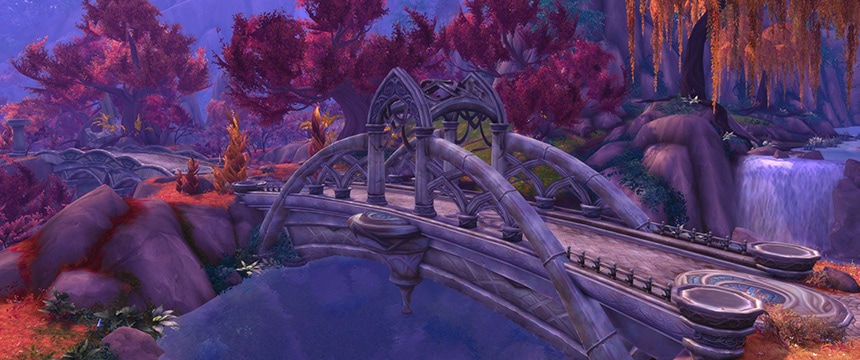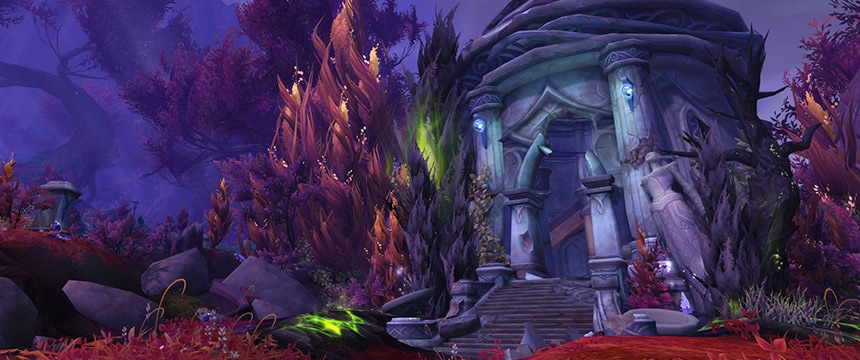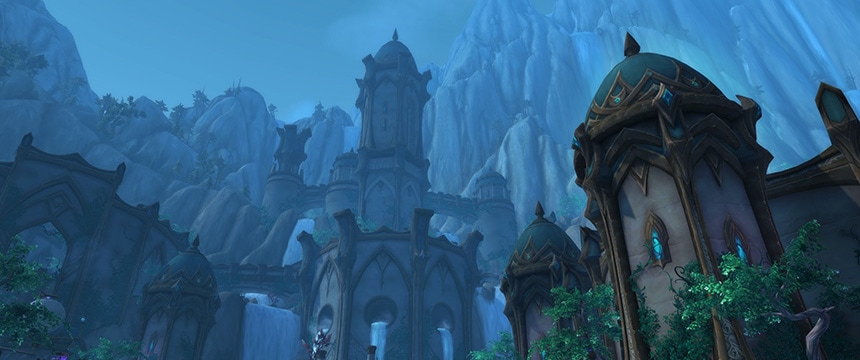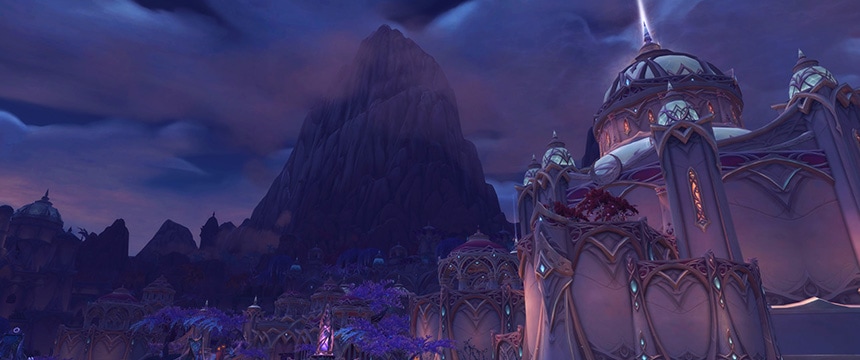Legion Zone Overview: Suramar
In this zone overview, we sat down with Senior Game Designer Steve Burke to talk about Suramar, the new maximum-level zone in Legion, to learn more about what you’ll experience there.
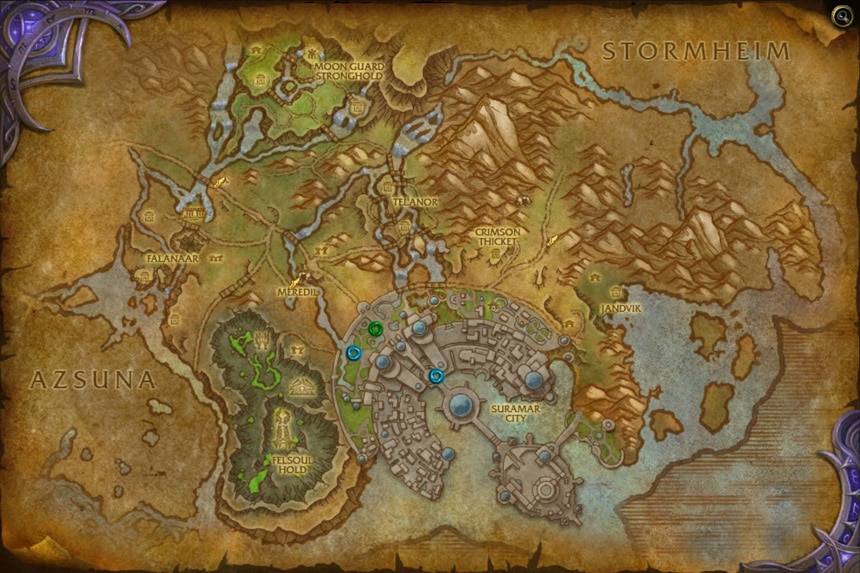
All roads lead to Suramar, an ancient elven metropolis at the heart of the Broken Isles. The corrupted Nightwell fuels the nightborne elves and provides them the sustenance they need to survive. Those who are cut off from it live as nightfallen, their bodies wasting away as they search desperately for the magical energy they need to sustain them. Atop the palace of Suramar, deep within the walls of the massive city, the warlock Gul’dan plots the next step of the Legion’s grand scheme. . . .
Q. How would you describe the zone's ambience?
Steve:Suramar is steeped in history. This is the elven capital. Here we have the Nightborne, which is a new group of characters, but really it’s an ancient group. These are the old night elves, and they were the rulers of the world at one point in time.
One of the things that’s cool about this zone is the Nightborne have retreated within a bubble for the last 10,000 years, so the land around them has become ruined and overgrown. There’s a collapsed location that players will see that I just love—it really helps show and tell that story.In the northeast, we have the Moonguard, the remnants of an ancient order of super-powerful mages. They have this deep history, and Illidan had even been one of them—a commander of the Moonguard. At this time, everyone who was born with yellow eyes was taken to join them. It was a great honor to be trained to become one of them—they were a really powerful force.
This being a level-110 zone, you can’t start questing until you’ve gotten to maximum level. This makes Suramar a unique zone in Legion, and creates a special vibe for the zone—you can really sit back and enjoy the story at your own pace. And because you aren’t leveling, we wanted to build this zone a little bit differently. For one, we wanted a lot of discoverable things, so that if you’re out exploring you have lots to happen upon along the way. You’re not going to be lead to them, though. You’re meant to gradually explore the zone and all of its nooks and crannies, and take it all in a bit at a time.
When creating the various locations around Suramar, we wanted to remind players of the different experiences they had as they leveled up, and remind them of all of the crises that have happened. So we have a little follow-up for Val’sharah, with some druids who have come in as refugees from the Nightmare. We have some vrykul. We even have some underwater experiences that might remind players of Vashj’ir. And of course, we also have the Burning Legion—we wanted a wide variety to make sure that Suramar hit more than one note.
We also really wanted to have an “exclamation point” in this zone. We did that with Suramar City. We’ve done big cities before like Silvermoon, but this one is a really special place. It’s urban, but it’s an adventure zone—a hostile city, which makes it special all on its own. And the artists just knocked it out of the park.
We wanted to show players a different perspective here, too, and make sure people really understood the Nightborne and everything that’s really going on here. We wanted to give you a look from the inside, and decided to use a disguise mechanic so you could infiltrate their society and really get a sense of what it’s like to be one of the Nightborne. You can get quests from Nightborne characters you otherwise would have been fighting. It was a little bit risky to do, but I think it’s played out really well.
Q. How are players introduced to this zone? And since it’s max-level, how does the story progress here?
Steve: When you reach max level, you get a quest in Dalaran. Khadgar has intercepted a signal and wants you to investigate. There’s this call for help from one of the exiled Nightborne that you might have read about in the comic “Twilight of Suramar,” which shows the events that lead right up to the quest. You are thrown right in with Thalyssra, who is the wounded Nightborne there, and you get to see firsthand the effects of the Nightwell on them for this past 10,000 years. They’ve come to rely on it so heavily, and being exiled from the city is a fate worse than death. As soon as they’re exiled, they begin deteriorating fast—until they become a mindless husk forever. We really wanted to make sure you feel that tension.
While their situation is hopeless, there is something that the player can do to help—even if it’s just trying to stave off this terrible thing for the last of these very noble people and this great elven culture. They’re descending into corruption and clinging to life, but the player can keep them from slipping into that. We wanted to make the gameplay around this experience something that wasn’t too onerous, but also something that you didn’t just dismiss. We wanted to give context to the moment-to-moment gameplay so that people care about what they are doing. There’s a lot of tragedy here, but there’s hope too.
You’ll also get to visit with people you know here—your old friends, if you will. There’s some lighthearted moments here too, but we hope we evoke a lot of goosebumps. There’s an emotional story to experience here, and we hope we’ve succeeded in delivering that to players.
Q. Which locations would you say are some of your favorites, and why?
Steve: Aside from the city—which the artists really outdid themselves on—there are several stories and locations that stand out, like Moonguard. The tale of the mages there is great, and the mountain retreat where they train is awesome. Tel’anor is also really awesome—at first we didn’t know quite what we were building, but after playing with ideas back and forth with the level designers, it eventually became clear: this is a graveyard. This is where their old heroes go to rest. I think they executed on that really well. It’s a beautiful location.
But Falanaar is my favorite. It’s big. It’s actually bigger than a dungeon. The story is that there’s an underground network in the zone with these ancient, elven-build halls—it really gives another dimension to the zone, and the location and the amazing visuals really show the age of it. Like I said, we’re talking about an area that’s 10,000 years old—it’s actually collapsed in parts, and there’s nothing quite like this in World of Warcraft. You get to go down and explore the depths. In places you can see the water from the surface above, breaking through and coming down into it.
Once we got the rough pieces in place, we realized this was really going to be a special place. We also knew that with the way World Quests work, we’d be bringing players back here, so we wanted an area that was worthy of that. It’s a place you can take the time to explore and take in all of the details at your own pace. There’s a world boss here. There are a few different entrances to it as well, which should make it fun for explorers. Both this location and Suramar city are really fantastic locations for people to visit, explore, and experience.
There are also suburbs up at the top, which we wanted to keep separate and distinctive. We wanted to show what the Nightborne are like without the demons—the juxtaposition between this noble and ancient race and this corrupt demonic force. We wanted to make you wonder, “How did they get to the state they’re in now?” We really wanted to have a location that allowed you see them in their own setting—clear of demons and pristine. It’s all just Nightborne in their natural habitat, though there’s still that vibe that the place is still unfriendly to people who aren’t one of them. You’ll get to see them in that environment first, and then a little later you get sent further into the depths of the city where you get to see the involvement of the Burning Legion.
With the Nightborne, there are no slums—there are just grades of “How elite are you?” They’ve all been in this bubble for 10,000 years, and they’re trained in hand-to-hand combat and spellcasting. They’re these consummate warriors, but they train as sort of a sport. Because for most of that time, there was no threat. They were closed off from the world. They worked on becoming as elegant as they could, and now you’ve got this arrogant, super-refined culture colliding with the forces of Gul’dan. You’re seeing Felguard marching around these pristine neighborhoods. It’s jarring.
It resonates, though, and you get a feel of most of the society wondering, “What have we done here?” And at the same time, they’re paralyzed with fear because they don’t want to be exiled. They don’t have any choice but to stay so they can partake of the Nightwell—but now they’re rationing out the mana wine. Now there’s scarcity and hunger in the streets. You’ve got this real contrast between those who are all in and marching to the drum of Elisande and her advisors, and the people who aren’t and the scarcity they deal with. There’s a sense of oppression. The place seems ripe for the people to rise up against the leadership, but they are paralyzed with fear that they could be cut off from the Nightwell.
Q. How often should players expect to return to this zone and the city of Suramar?
Steve: This is an easy one. This is a max-level zone, so we wanted to make sure we really built it with the end-game in mind. We wanted to make sure players had plenty to do. I think that the World Quests are rewarding and going to pull you all across the expansion, and then when you’ve knocked those out for the day, this is the place you’re going to come back to so that you can absorb the story. It plays out over time and will lead up to the raid that will be available here later. I hope people live here when they aren’t in their Order Hall or out doing World Quests.
